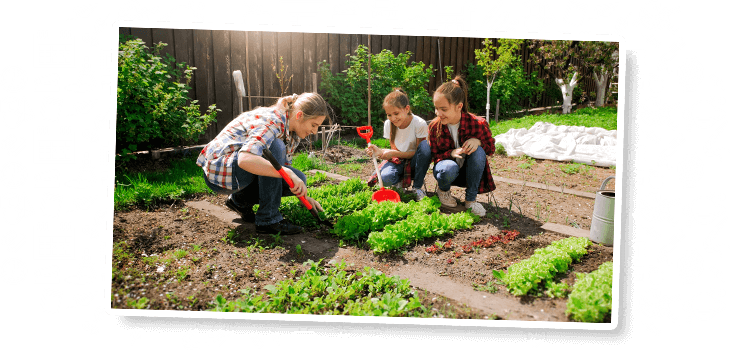Each April we celebrate Earth Day. It’s that perfect time of year to begin making more eco-friendly decisions and to let your children’s passion for the planet flourish.
This love for Mother Nature also has other benefits. Research shows that playing and learning outdoors in the natural world benefits children’s physical health and social-emotional development. And homeschooling with Time4Learning allows you and your family the flexibility and mobility to fit outdoor activities into your learning schedule!
Integrate Sustainable Habits and Long-Term Projects
Teaching kids to keep the environment clean is a lifelong lesson. These tips are not only educational and fun but also support Mother Nature’s well-being today and tomorrow. While Earth Day falls on April 22, the spirit of Earth Day should be a year-round commitment. Encourage your child to explore projects and habits to care for our planet sustainably throughout every season.
- Encourage birds and pollinators to visit your yard by providing food, shelter, and water sources. Plant native wildflowers in early spring to provide shelter and food. Create a nature journal where your children can record observations, add pictures or videos, and collect data on different wildlife that visits your habitat.
- Make a rain bucket with your kids. For this, you’ll need a 55- to 75-gallon plastic rain barrel or garbage can, leaf screens, and spouts. Keep the rain barrel covered to prevent bugs and debris from getting in. This will help protect you, your children, and your pets. Use the water on flowers, shrubs, and the lawn.
- Join or start a community cleanup. Find a local community group or gather a group of friends to pick up trash at a local park, nature trail, or beach. Conduct research ahead of time to learn about local plants and wildlife, and how human waste impacts their natural habitats. Reflect with your children after the field trip–what did they observe while collecting trash? How does human waste intervene with the ecosystem?
- Reuse and recycle at home: Many families already recycle, but this project takes it to another level by looking at recycling on a more granular level. In this project, your kids will create a chart that analyzes how you are currently disposing of waste, whether items being thrown away could be reused, recycled, or composted, and ways the family can make improvements. This tool will not only help track activities, but it will also serve as an effective visual reminder to keep this topic top of mind. This free recycling guide will help you get started.
- Embrace community engagement: Earth Day is a perfect time to lend a helping hand to local organizations that support your community and have the environment in their best interest. Churches, youth groups, environmental clubs, and other local civic organizations are often looking for young volunteers. This type of community involvement could lead to scholarship opportunities and would look especially good on future transcripts and resumes. Above all, you will be making a difference by supporting organizations that help others – a true win-win!
- Try sustainable fashion: Did you know that 60% of all clothing is made of synthetic fibers and that washing them releases harmful microplastics, contributing to 35% of all ocean microplastic pollution? Investing in eco-friendly clothing made from natural materials, such as organic cotton, linen, or hemp can help alleviate that waste. Learn how to repair your family’s clothes with your child to help keep textiles out of the landfill and practice useful life skills. Look to buy secondhand or from clothing brands that are environmentally responsible and manufactured in local communities. Buying locally reduces harmful emissions related to travel too.
- Plant a vegetable garden: Vegetable gardens benefit the environment and teach valuable, hands-on science lessons. Locally grown vegetables reduce carbon emissions from burning fossil fuels and reduce harmful pesticides and other chemical applications. Investigate different growing methods such as organic and environmentally-friendly soil mixtures. You can save money by growing your own food and having easy access to veggies will foster a healthier lifestyle!
- Give up single-use items on the go. Just think about all the straws that restaurants throw in the trash. By giving those up altogether, or using reusable ones, your family can help reduce that environmental impact. Another way to reduce your waste is to bring your own containers for leftovers.
These are just a few long-term projects and sustainability habits, but the opportunities are endless, so use your imagination and experiment with a few others. While Time4Learning’s homeschooling curriculum is based online, there are plenty of ways to integrate outdoor activities and experiences alongside lessons from any subject. Get creative and involve your kids in the brainstorming process!
Earth Day is not just about our planet, it’s about the people who live on our planet! When children become passionate about a topic, parents take notice. Using math, science, reading, art, critical thinking, technology, environmental studies, and problem-solving skills, kids take ownership of their Earth Day projects and actually feel like they are making a difference. That’s a powerful feeling for all kids – and you can help them achieve it.






